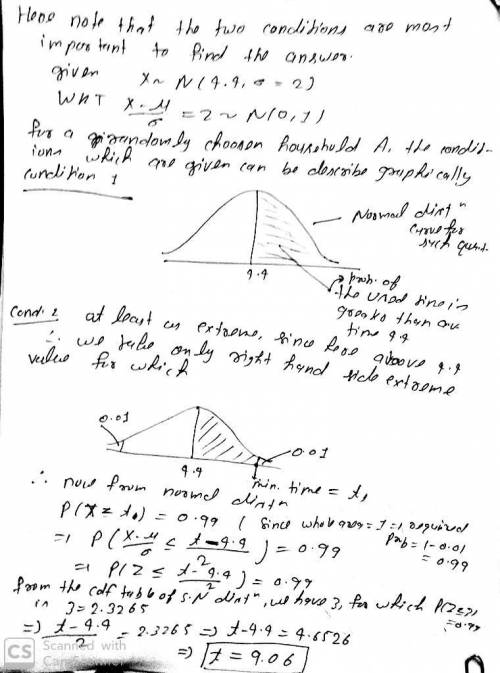
Business, 19.05.2020 15:10 hussain5889
A personal computer is used for office work at home, research, communication, personal finances, education, entertainment, social networking, and a myriad of other things. Suppose that the average number of hours a household personal computer is used is 4.4 hours per day, across the population of households in the United States. Assume the the population of household usage times is normally distributed and the standard deviation for the times is 2 hours.
You are told that a given household (Household A) from the population has the following two qualities
1. It uses its computer an above-average number of hours per day.
2. The probability of randomly drawing a household with a computer-usage at least as extreme (i. e., combining across extremely high and low usage rates) as Household A is 0.02.
What is the minimum number of hours per day that Household A must use its computer? Round your answer to the second decimal place. If you can't find the exact table entry you're looking for, use the table entry that's closest. If there's a tie, use the smaller of the two options.
**please explain each step to get the correct answer. Answer is 9.06

Answers: 2


Another question on Business

Business, 21.06.2019 21:30
In a macroeconomic context, what are implicit liabilities? money owed to people possessing government issued bonds. the amount of money that firms collectively owe to shareholders. money that the government has promised to pay in the future. payments that the federal government undertakes only during periods of recession. which of the choices is a significant implicit liability in the united states? military spending education spending national science foundation spending social security
Answers: 2

Business, 22.06.2019 03:30
Assume that all of thurmond company’s sales are credit sales. it has been the practice of thurmond company to provide for uncollectible accounts expense at the rate of one-half of one percent of net credit sales. for the year 20x1 the company had net credit sales of $2,021,000 and the allowance for doubtful accounts account had a credit balance, before adjustments, of $630 as of december 31, 20x1. during 20x2, the following selected transactions occurred: jan. 20 the account of h. scott, a deceased customer who owed $325, was determined to be uncollectible and was therefore written off. mar. 16 informed that a. nettles, a customer, had been declared bankrupt. his account for $898 was written off. apr. 23 the $906 account of j. kenney & sons was written off as uncollectible. aug. 3 wrote off as uncollectible the $750 account of clarke company. oct. 20 wrote off as uncollectible the $1,130 account of g. michael associates. oct. 27 received a check for $325 from the estate of h. scott. this amount had been written off on january 20 of the current year. dec. 20 cater company paid $7,000 of the $7,500 it owed thurmond company. since cater company was going out of business, the $500 balance it still owed was deemed uncollectible and written off. required: prepare journal entries for the december 31, 20x1, and the seven 20x2 transactions on the work sheets provided at the back of this unit. then answer questions 8 and 9 on the answer sheet. t-accounts are also provided for your use in answering these questions. 8. which one of the following entries should have been made on december 31, 20x1?
Answers: 1

Business, 22.06.2019 12:10
Laws corporation is considering the purchase of a machine costing $16,000. estimated cash savings from using the new machine are $4,120 per year. the machine will have no salvage value at the end of its useful life of six years and the required rate of return for laws corporation is 12%. the machine's internal rate of return is closest to (ignore income taxes) (a) 12% (b) 14% (c) 16% (d) 18%
Answers: 1

Business, 22.06.2019 17:10
At the end of the current year, accounts receivable has a balance of $550,000; allowance for doubtful accounts has a credit balance of $5,500; and sales for the year total $2,500,000. an analysis of receivables estimates uncollectible receivables as $25,000. determine the net realizable value of accounts receivable after adjustment. (hint: determine the amount of the adjusting entry for bad debt expense and the adjusted balance of allowance of doubtful accounts.)
Answers: 3
You know the right answer?
A personal computer is used for office work at home, research, communication, personal finances, edu...
Questions


English, 15.07.2019 12:30




Mathematics, 15.07.2019 12:30

Spanish, 15.07.2019 12:30

History, 15.07.2019 12:30









Health, 15.07.2019 12:30

Mathematics, 15.07.2019 12:30

Advanced Placement (AP), 15.07.2019 12:30

Chemistry, 15.07.2019 12:30




